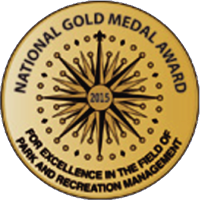- CRC
Age-Based Interests
- Program Guide
- Programs
Age-Based Interests
- Schedules
- Register
Registration Information
- CRC
Age-Based Interests
- Program Guide
- Programs
Age-Based Interests
- Schedules
- Register
Registration Information
PERFORMANCE
The Park District works to continuously address the needs of the community and improve the quality of services, parks, and facilities without relying solely on taxes to support these efforts. The following charts measure the Park District’s efforts in maximizing alternative funding, efficiently aligning resources, and managing funds and debt in a sustainable manner.
Non-Tax Revenue includes the percent of revenue collected by the Park District that does not come from the local tax levy, such as program revenue, fees and charges, sponsorships and donations, intergovernmental revenue (including grants), rental income, other miscellaneous revenue (including non-resident fees, vending machine revenue, rebates, etc.), and other financing sources (including debt service proceeds and transfers). The Park District’s overall goal is to reach 50% by 2020. Hover over the chart for more detail.
Note: From 2011-2013, the Park District issued $10 million in debt each year to help fund capital improvements including the Gymnastics & Recreation Center, Ridgeland Common Recreation Complex, and renovation to the John Hedges Administrative and Building & Grounds facility. This partially led to the increases in revenue displayed for those years. A decline from 2013 to 2014 was anticipated as the revenue from the bond sales was no longer present.
*Data for this chart is updated annually from results from the Park District’s annual audit.
Who are the stakeholders impacted?
Program participants and staff
What does the data say?
The Park District’s overall goal is to be above 50%, which was achieved in 2018. Final numbers were not available for 2019 at the time of this report.
What is causing the data trend?
Growth in all programs and small fee increases
What outcome are we trying to achieve?
Maximize funding to be financially strong
Fund Balances are a ratio of total fund assets to total fund expenditures. The Government Finance Officers Association recommends 25% as a fund balance target because it is a healthy balance between having enough cash in reserves to handle operations without putting an undue tax burden on the community. The Park District strives to keep fund balances between 25-30%, except for the Museum Fund, which is a hybrid fund that the Park District works to maintain at 75-80%.
*Data for this chart is updated annually in April from results from the Park District’s annual audit.
Who are the stakeholders impacted?
Staff and the Community
What does the data say?
The fund balances of the Park District’s 10 funds continue to be strong. The Cheney Mansion fund continues to perform well increasing its fund balance from 46% to 88% from 2017 to 2018. Final numbers were not available for 2019 at the time of this report.
What is causing the data trend?
The positive results are from strong financial performance in our Recreation programming as well Cheney Mansion. The other growth is attributed to lower than expected spending across the board.
What outcome are we trying to achieve? Optimize return on investment to be financially strong
Volunteer hours include the total number of volunteer hours reported by Park District supervisors at facilities, special events, citizen committees, and other efforts as well as the amount it would cost the Park District if those volunteers had to be replaced by staff working at minimum wage ($8.25/hour).
Who are the stakeholders impacted?
Staff, Volunteers, and the Community
What does the data say?
The number of volunteer hours worked at the Park District in 2019 increased by about 2% from 2018.
What is causing the data trend?
A large improvement in Youth Sports volunteer hours
What outcome are we trying to achieve?
Align resources efficiently to be financially strong
Fund performance compares the difference between the overall net revenue budget for each fund versus the actual results to date. Accurate budgeting ensures that the Park District is able to serve as much of the community as possible and allows the agency to plan additional park & facility improvements without any additional cost to the tax payers. Although staff strive to stay within 10% of their budget, they also work to remain nimble and able to take advantage of new opportunities for programs, rentals, grants, and cost savings.
*Data for this chart is updated automatically as financial transactions are processed by the Park District’s finance department.
Who are the stakeholders impacted?
Staff and the Community
What does the data say?
Compared to the Budget, the revenue for Corporate, Recreation, Special Facilities funds finished up 6%, 3%, and 5% respectively. The Cheney Fund finished –9%. While Cheney finished lower than revenue projections, revenue was still nearly 4% higher than 2018.
What is causing the data trend?
The Cheney Fund finished –9%, due to lower than expected wedding and event rentals.
What outcome are we trying to achieve?
Sustainable financial plans to be financially strong
The Park District defines the measurement as the percent of property tax revenue collected in the current year by the Park District compared to overlapping jurisdications such as county, village, township, library, school districts, community colleges, and other special districts.
Who are the stakeholders impacted?
Community and staff
What does the data say?
The Park District saw it’s percent of the Oak Park community tax bill grow from 3% from 2017. Final numbers were not available for 2019 at the time of this report.
What is causing the data trend?
One of the reasons for the increase is District 200 participated in a property tax relief program through the State of Illinois, lowering their levy in exchange for matching funds. As a result, our share of the property tax percentage grew.
What outcome are we trying to achieve?
Maximize funding to be financially strong




